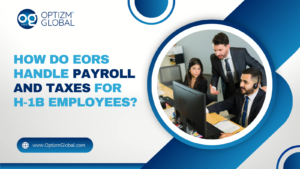For most startups and small-to-midsize companies, the H-1B visa has been an established path to bring high-level technical and professional talent from overseas. But increased H-1B shortages, longer processing times, and changing American policy have led some employers to pose a straightforward question: Can work solutions (EORs, PEOs, and remote-work models) replace the necessity of H-1B sponsorship? The short answer: sometimes, but not necessarily always. Let’s see when employment solutions are genuine alternatives and where they fall short.
Why employers are searching for H-1B alternatives now
Two trends have hastened interest in non-Visa employment models. First, the H-1B process is competitive and unpredictable. USCIS registration statistics indicate the H-1B cap continues to be oversubscribed in some years; the registration and selection process produces lottery risk and timeline uncertainty for employers and candidates. For instance, USCIS’s FY2026 report recorded the registration and selection process numbers that employers closely monitor when making hiring plans.
Second, policy and market developments are increasing sponsorship costs or unpredictability for many employers. Large employers and consultancies are changing recruitment models due to policy changes and charges, and some companies are signaling publicly lower reliance on visa sponsorship. For example, Tata Consultancy Services (TCS) has announced it is reducing H-1B dependence and bringing in more locals in the U.S. It’s an indication that large-scale employers are reconsidering dependence on sponsored labor.
These forces compel businesses to look at employment solutions that allow them to access global talent quickly without establishing foreign units or dealing with visa timelines.

What do “employment solutions” mean?
Employer of Record (EOR)– a third party that legally employs talent for you in the worker’s own country (handles payroll, taxes, benefits, compliance).
Professional Employer Organization (PEO)– usually a co-employment solution used domestically to offer HR and benefits to small businesses.
Contractor marketplaces / freelance platforms- for short-term or project work, where classification rules allow.
Remote-first hiring without relocation- direct hire in the candidate’s country (if legal) or through a local entity when required. Authentic EOR/remote-hiring vendors like Optizm Global have developed mature services to automate these flows.
Where employment solutions can stand in for H-1B sponsorship
When you don’t require the employee onsite in the U.S.
If the responsibilities of the job can be done remotely from the home country of the worker, an EOR or direct local hiring usually eliminates the necessity for sponsoring an H-1B. The employer still maintains control over the day-to-day work while the EOR manages legal employment responsibilities in-country, quicker and with less initial legal setup than establishing a local subsidiary. Increasingly, companies now remotely hire experts via EORs to eliminate relocation.
For pilot programs or short-term market testing
If a company wishes to pilot a product for 6–12 months in a new market or requires a few contractors, hiring talent through an EOR or a qualified contractor marketplace is typically the quickest, most affordable path.
To mitigate hiring timeline risk
H-1B processing times (registration, selection, consular processing) can be several months. EORs facilitate immediate starts in most countries, which is essential for hiring time-sensitive positions.
Where work solutions cannot substitute H-1B (or are constrained)
When the worker needs to physically work in the U.S.
Only a suitable visa (H-1B, L-1, O-1, TN, etc.) permits physical work on U.S. ground. When the job needs one to be present in the U.S. — to abide by local regulations, for security clearance, or to work alongside the locals — an EOR does not replace a U.S. work visa.
Permanent relocation and immigration ambitions
Staff members pursuing a route to U.S. permanent residence (green card) will typically have to be on an employer-sponsored visa, such as the H-1B, to pursue conventional employer-sponsored immigration pathways. An EOR working in the home country will not support U.S. immigration benefits.
Compliance nuance & classification risk
The classification of remote workers versus contractors is legally precarious. Misclassification generates back taxes, penalties, or employment obligations. EORs minimize this risk, but don’t eliminate it; cautious legal advice remains necessary.
Best Solutions
- EOR vendors’ expansion & product positioning: Major vendors such as Optizm Global position their EOR solutions directly as speedy substitutes for relocation and sponsorship of visas for work that can be performed remotely. It’s a utilitarian indication that lots of companies are already opting for EOR engagements instead of sponsorship for specific jobs. These platforms have also increased immigration solutions where sponsors remain in need of visa assistance, indicating a mixed market.
- Enterprise movement away from sponsorship: Major employers are actively moving away from H-1B sponsorship dependence and local hiring, both policy reaction and changes in hiring strategy (e.g., TCS’s public statements). This movement makes room for employment solutions and offshoring to serve as substitutes.
A pragmatic, hybrid playbook
Categorize jobs by location dependence: Sponsor H-1B only if the job needs to be in the U.S.; otherwise, facilitate remote hire through EOR or direct local hire.
- Utilize EORs for speed and compliance: For pilots, tests, and time-sensitive hires, EORs cut down delay and legal bureaucracy.
- Save H-1B for strategic relocation: Employ visa sponsorship sparingly for staff required to be present in the United States or for essential long-term immigration strategies.
- Watch cost vs. value: Consider EOR charges, possible differences in taxes, and preferences of candidates; in certain markets, the total cost of employment can be less remote than sponsoring and relocating.
- Keep legal counsel: Immigration and employment law complexity requires counsel, so you don’t exchange one compliance risk for another.
Conclusion
Solutions in employment can solve the H-1B visa need in most, but not all, circumstances.
If the job can be done remotely or the business is piloting a market, EORs and contractor marketplaces are quick, and widely compliant alternatives. On the other hand, if physical work in the U.S. is required for the job or company and the worker envisions a future U.S. immigration route, H-1B (or other U.S. visas) are still necessary. The best practice for most companies is hybrid: employ a solution for velocity and agility and hold back sponsorship assets for those positions that really need a U.S. presence.






